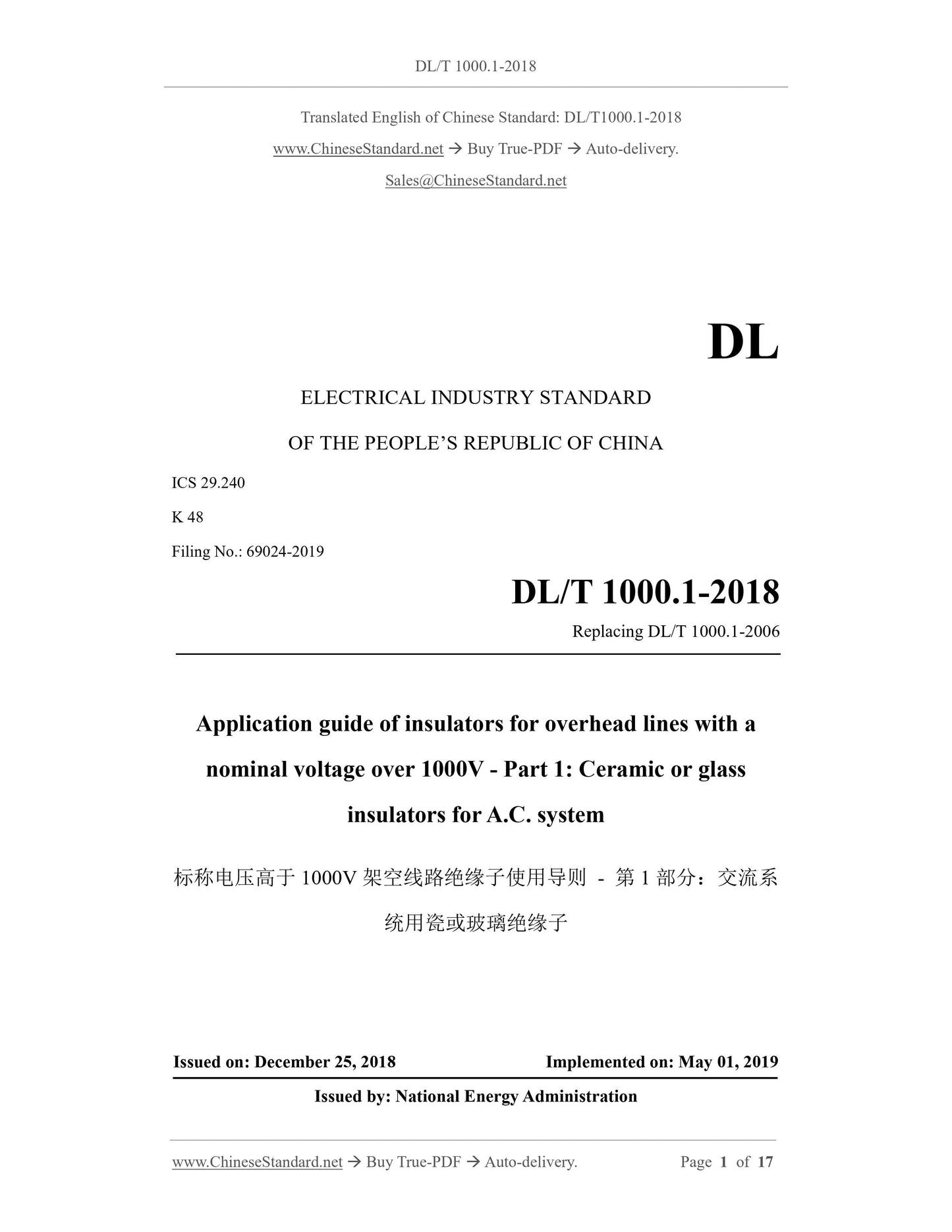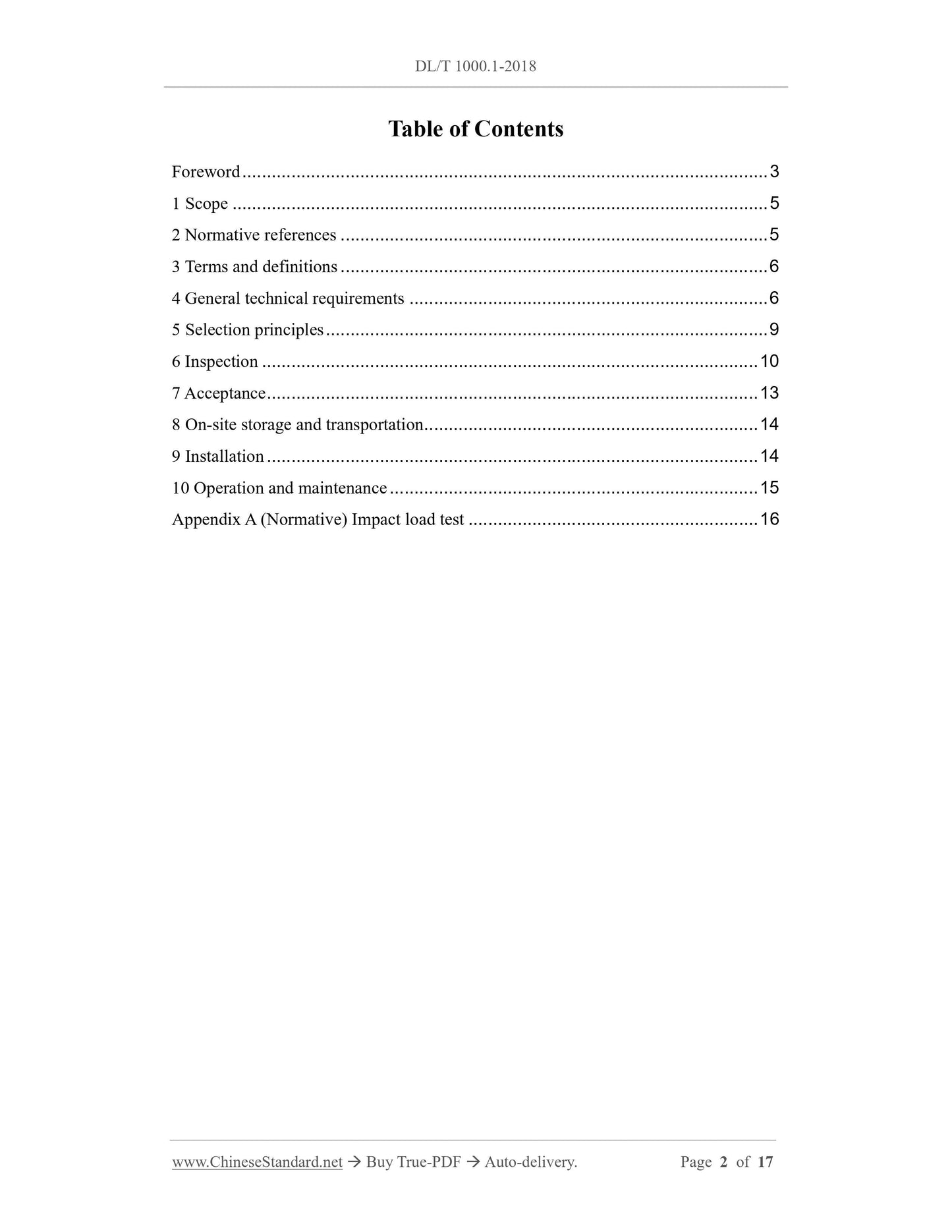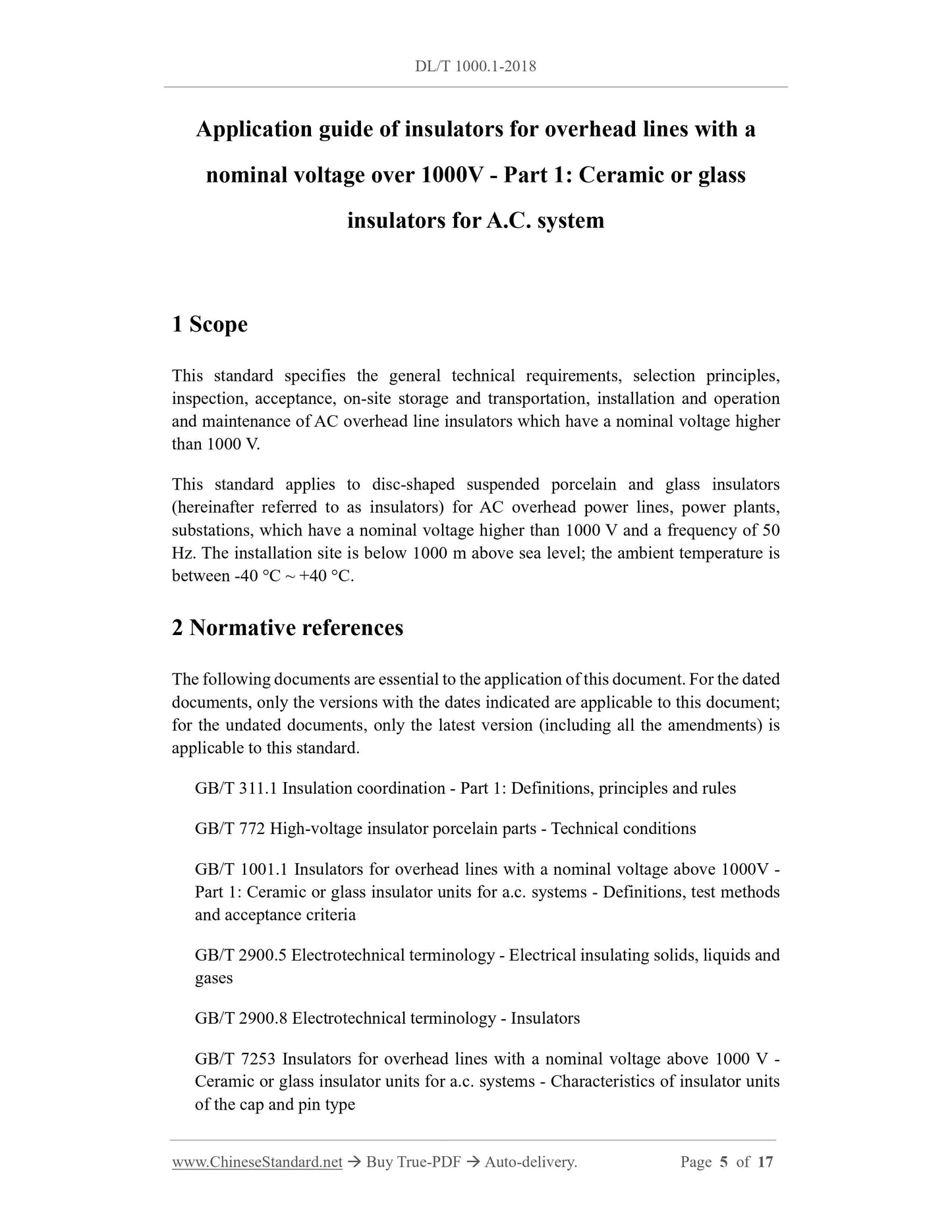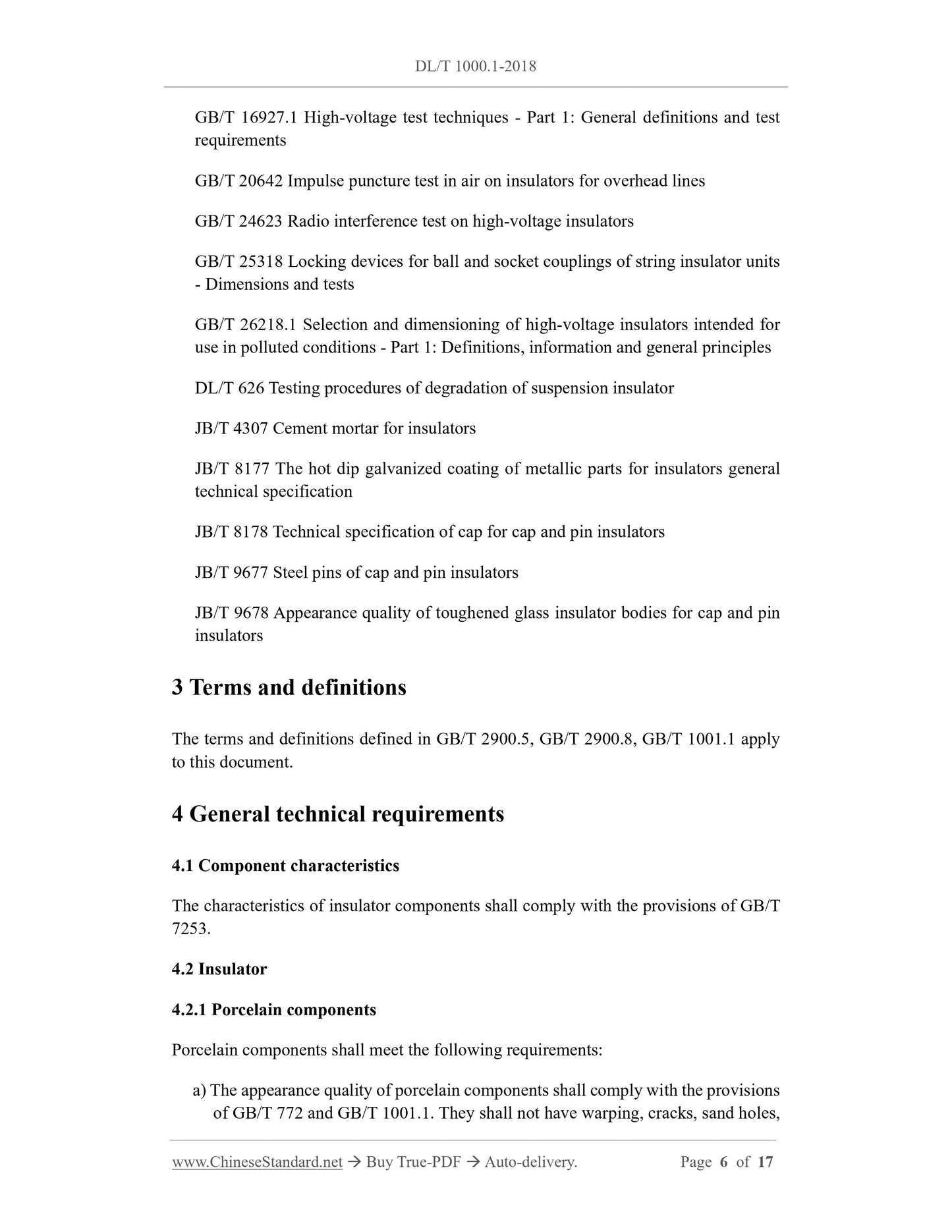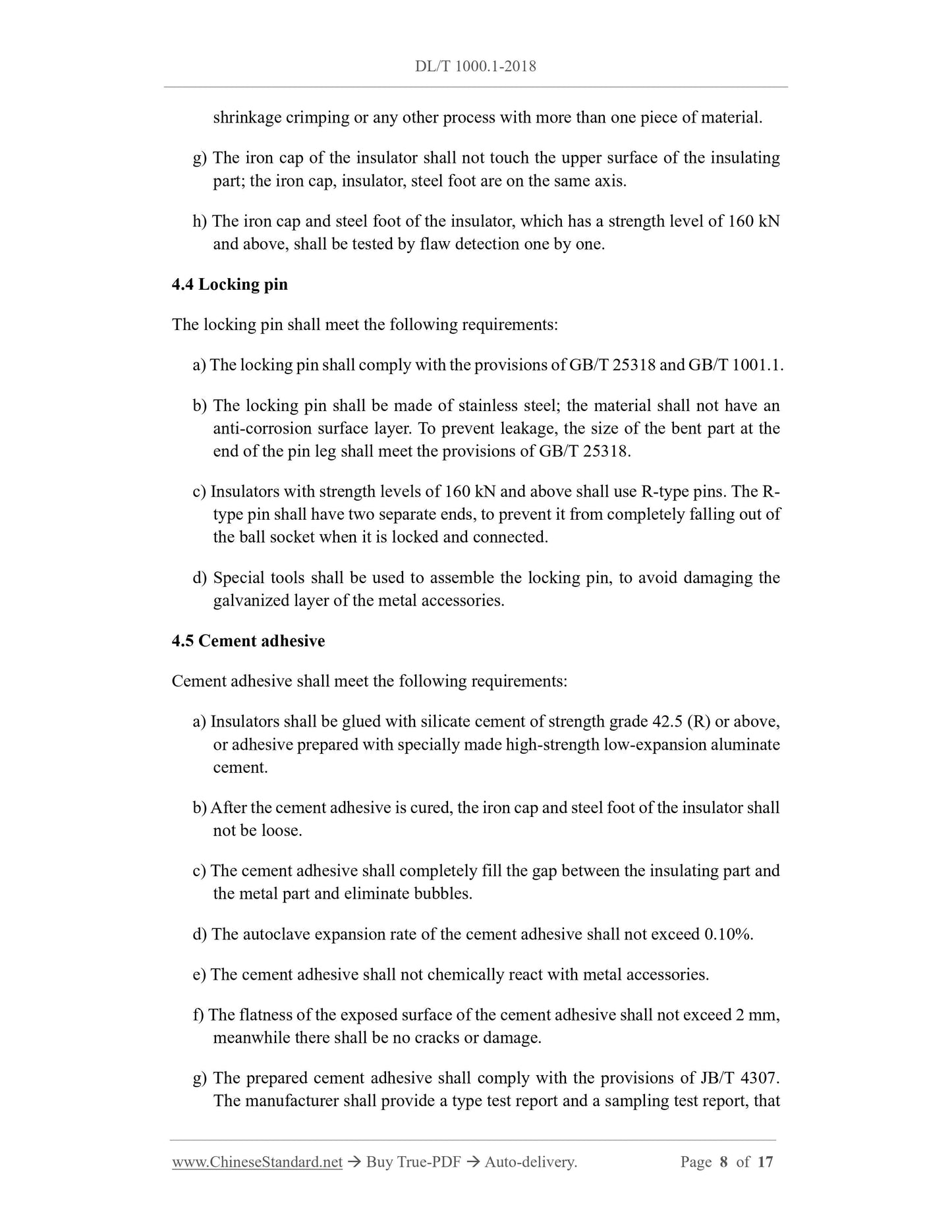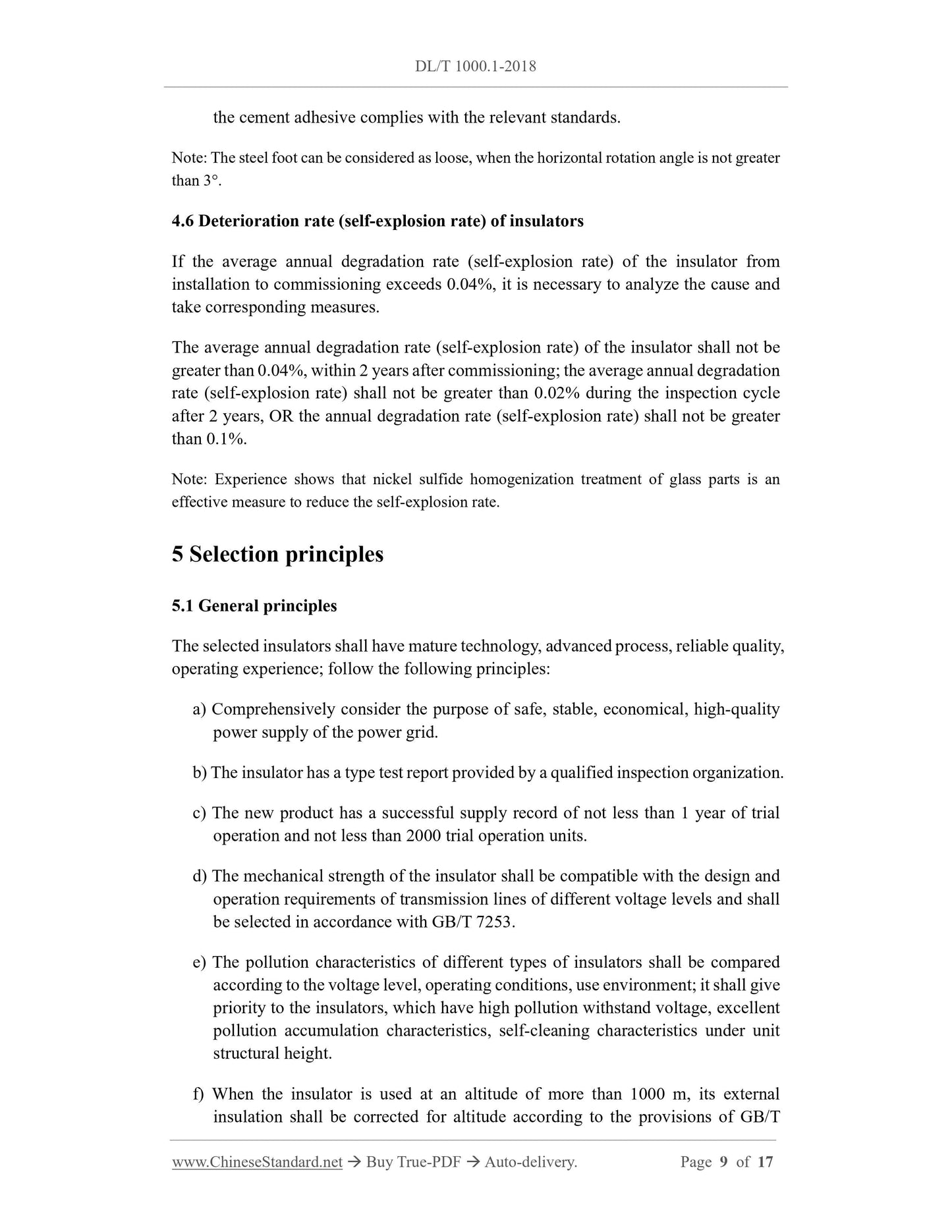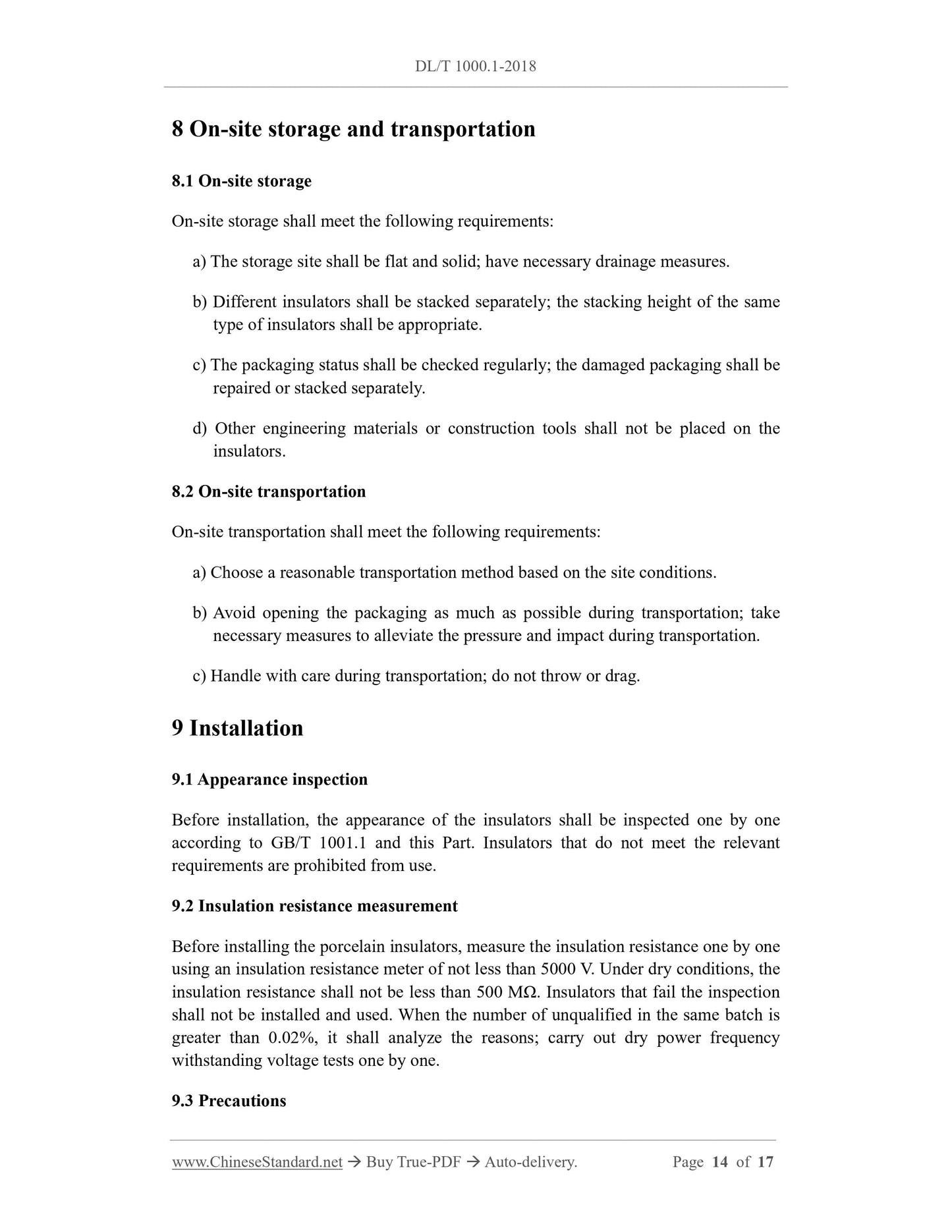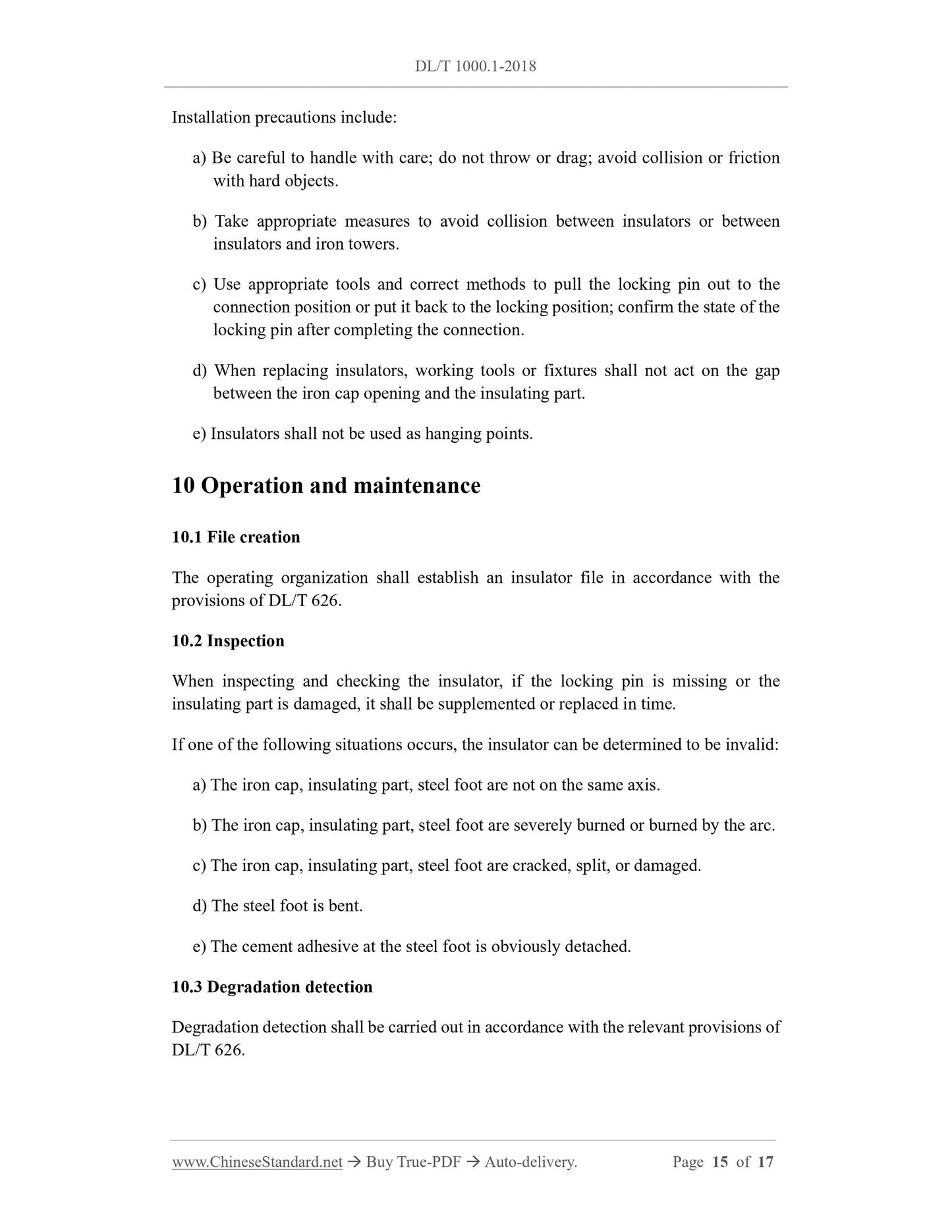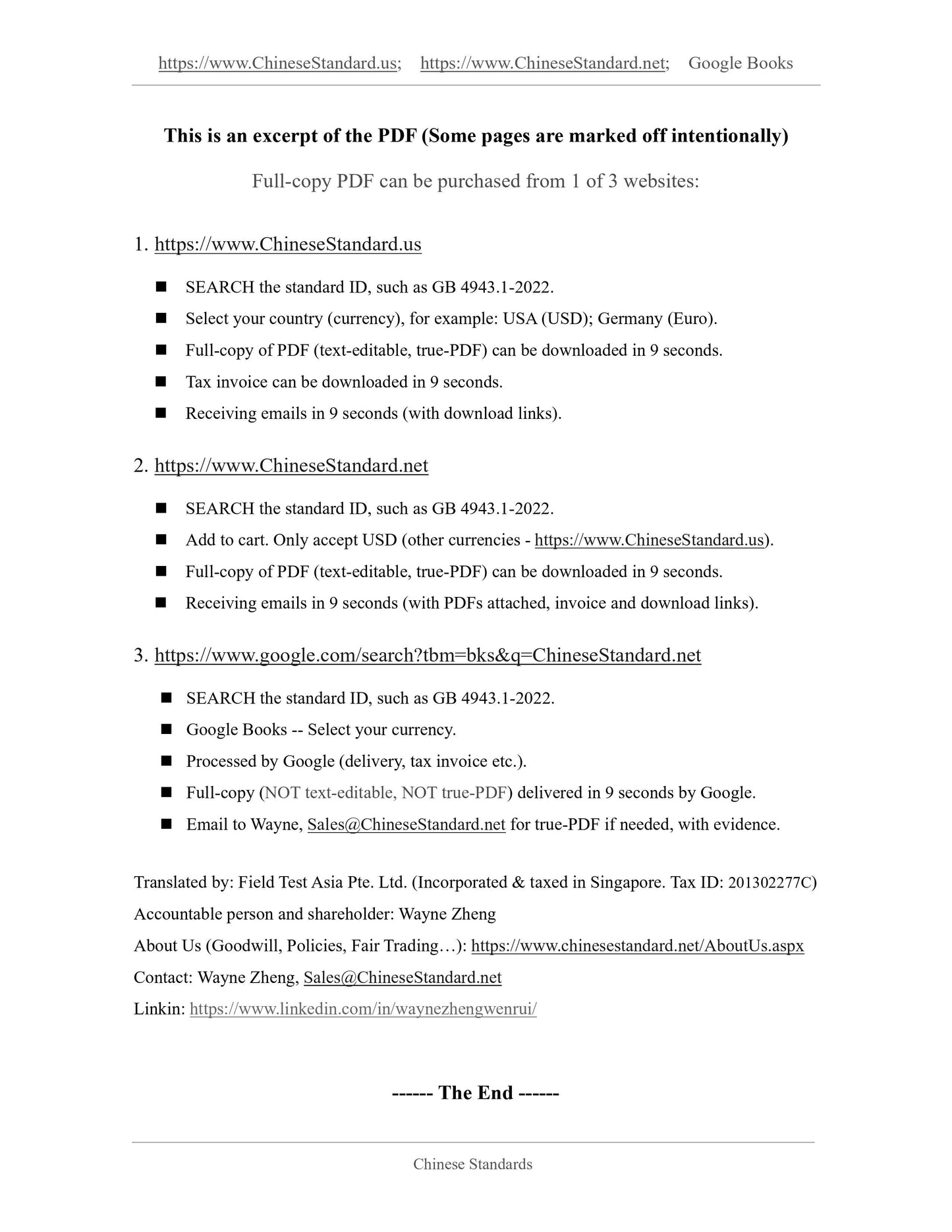PayPal, credit cards. Download editable-PDF and invoice in 1 second!
DL/T 1000.1-2018 English PDF (DLT1000.1-2018)
DL/T 1000.1-2018 English PDF (DLT1000.1-2018)
Precio habitual
$205.00 USD
Precio habitual
Precio de oferta
$205.00 USD
Precio unitario
/
por
Los gastos de envío se calculan en la pantalla de pago.
No se pudo cargar la disponibilidad de retiro
Delivery: 3 seconds. Download true-PDF + Invoice.
Get QUOTATION in 1-minute: Click DL/T 1000.1-2018
Historical versions: DL/T 1000.1-2018
Preview True-PDF (Reload/Scroll if blank)
DL/T 1000.1-2018: Application guide of insulators for overhead lines with a nominal voltage over 1000V. part1: Ceramic or glass insulators for a. c. systems
DL/T 1000.1-2018
DL
ELECTRICAL INDUSTRY STANDARD
OF THE PEOPLE’S REPUBLIC OF CHINA
ICS 29.240
K 48
Filing No.: 69024-2019
Replacing DL/T 1000.1-2006
Application guide of insulators for overhead lines with a
nominal voltage over 1000V - Part 1: Ceramic or glass
insulators for A.C. system
ISSUED ON: DECEMBER 25, 2018
IMPLEMENTED ON: MAY 01, 2019
Issued by: National Energy Administration
Table of Contents
Foreword ... 3
1 Scope ... 5
2 Normative references ... 5
3 Terms and definitions ... 6
4 General technical requirements ... 6
5 Selection principles ... 9
6 Inspection ... 10
7 Acceptance ... 13
8 On-site storage and transportation ... 14
9 Installation ... 14
10 Operation and maintenance ... 15
Appendix A (Normative) Impact load test ... 16
Application guide of insulators for overhead lines with a
nominal voltage over 1000V - Part 1: Ceramic or glass
insulators for A.C. system
1 Scope
This standard specifies the general technical requirements, selection principles,
inspection, acceptance, on-site storage and transportation, installation and operation
and maintenance of AC overhead line insulators which have a nominal voltage higher
than 1000 V.
This standard applies to disc-shaped suspended porcelain and glass insulators
(hereinafter referred to as insulators) for AC overhead power lines, power plants,
substations, which have a nominal voltage higher than 1000 V and a frequency of 50
Hz. The installation site is below 1000 m above sea level; the ambient temperature is
between -40 °C ~ +40 °C.
2 Normative references
The following documents are essential to the application of this document. For the dated
documents, only the versions with the dates indicated are applicable to this document;
for the undated documents, only the latest version (including all the amendments) is
applicable to this standard.
GB/T 311.1 Insulation coordination - Part 1: Definitions, principles and rules
GB/T 772 High-voltage insulator porcelain parts - Technical conditions
GB/T 1001.1 Insulators for overhead lines with a nominal voltage above 1000V -
Part 1: Ceramic or glass insulator units for a.c. systems - Definitions, test methods
and acceptance criteria
GB/T 2900.5 Electrotechnical terminology - Electrical insulating solids, liquids and
gases
GB/T 2900.8 Electrotechnical terminology - Insulators
GB/T 7253 Insulators for overhead lines with a nominal voltage above 1000 V -
Ceramic or glass insulator units for a.c. systems - Characteristics of insulator units
of the cap and pin type
GB/T 16927.1 High-voltage test techniques - Part 1: General definitions and test
requirements
GB/T 20642 Impulse puncture test in air on insulators for overhead lines
GB/T 24623 Radio interference test on high-voltage insulators
GB/T 25318 Locking devices for ball and socket couplings of string insulator units
- Dimensions and tests
GB/T 26218.1 Selection and dimensioning of high-voltage insulators intended for
use in polluted conditions - Part 1: Definitions, information and general principles
DL/T 626 Testing procedures of degradation of suspension insulator
JB/T 4307 Cement mortar for insulators
JB/T 8177 The hot dip galvanized coating of metallic parts for insulators general
technical specification
JB/T 8178 Technical specification of cap for cap and pin insulators
JB/T 9677 Steel pins of cap and pin insulators
JB/T 9678 Appearance quality of toughened glass insulator bodies for cap and pin
insulators
3 Terms and definitions
The terms and definitions defined in GB/T 2900.5, GB/T 2900.8, GB/T 1001.1 apply
to this document.
4 General technical requirements
4.1 Component characteristics
The characteristics of insulator components shall comply with the provisions of GB/T
7253.
4.2 Insulator
4.2.1 Porcelain components
Porcelain components shall meet the following requirements:
a) The appearance quality of porcelain components shall comply with the provisions
of GB/T 772 and GB/T 1001.1. They shall not have warping, cracks, sand holes,
shrinkage crimping or any other process with more than one piece of material.
g) The iron cap of the insulator shall not touch the upper surface of the insulating
part; the iron cap, insulator, steel foot are on the same axis.
h) The iron cap and steel foot of the insulator, which has a strength level of 160 kN
and above, shall be tested by flaw detection one by one.
4.4 Locking pin
The locking pin shall meet the following requirements:
a) The locking pin shall comply with the provisions of GB/T 25318 and GB/T 1001.1.
b) The locking pin shall be made of stainless steel; the material shall not have an
anti-corrosion surface layer. To prevent leakage, the size of the bent part at the
end of the pin leg shall meet the provisions of GB/T 25318.
c) Insulators with strength levels of 160 kN and above shall use R-type pins. The R-
type pin shall have two separate ends, to prevent it from completely falling out of
the ball socket when it is locked and connected.
d) Special tools shall be used to assemble the locking pin, to avoid damaging the
galvanized layer of the metal accessories.
4.5 Cement adhesive
Cement adhesive shall meet the following requirements:
a) Insulators shall be glued with silicate cement of strength grade 42.5 (R) or above,
or adhesive prepared with specially made high-strength low-expansion aluminate
cement.
b) After the cement adhesive is cured, the iron cap and steel foot of the insulator shall
not be loose.
c) The cement adhesive shall completely fill the gap between the insulating part and
the metal part and eliminate bubbles.
d) The autoclave expansion rate of the cement adhesive shall not exceed 0.10%.
e) The cement adhesive shall not chemically react with metal accessories.
f) The flatness of the exposed surface of the cement adhesive shall not exceed 2 mm,
meanwhile there shall be no cracks or damage.
g) The prepared cement adhesive shall comply with the provisions of JB/T 4307.
The manufacturer shall provide a type test report and a sampling test report, that
the cement adhesive complies with the relevant standards.
Note: The steel foot can be considered as loose, when the horizontal rotation angle is not greater
than 3°.
4.6 Deterioration rate (self-explosion rate) of insulators
If the average annual degradation rate (self-explosion rate) of the insulator from
installation to commissioning exceeds 0.04%, it is necessary to analyze the cause and
take corresponding measures.
The average annual degradation rate (self-explosion rate) of the insulator shall not be
greater than 0.04%, within 2 years after commissioning; the average annual degradation
rate (self-explosion rate) shall not be greater than 0.02% during the inspection cycle
after 2 years, OR the annual degradation rate (self-explosion rate) shall not be greater
than 0.1%.
Note: Experience shows that nickel sulfide homogenization treatment of glass parts is an
effective measure to reduce the self-explosion rate.
5 Selection principles
5.1 General principles
The selected insulators shall have mature technology, advanced process, reliable quality,
operating experience; follow the following principles:
a) Comprehensively consider the purpose of safe, stable, economical, high-quality
power supply of the power grid.
b) The insulator has a type test report provided by a qualified inspection organization.
c) The new product ha...
Get QUOTATION in 1-minute: Click DL/T 1000.1-2018
Historical versions: DL/T 1000.1-2018
Preview True-PDF (Reload/Scroll if blank)
DL/T 1000.1-2018: Application guide of insulators for overhead lines with a nominal voltage over 1000V. part1: Ceramic or glass insulators for a. c. systems
DL/T 1000.1-2018
DL
ELECTRICAL INDUSTRY STANDARD
OF THE PEOPLE’S REPUBLIC OF CHINA
ICS 29.240
K 48
Filing No.: 69024-2019
Replacing DL/T 1000.1-2006
Application guide of insulators for overhead lines with a
nominal voltage over 1000V - Part 1: Ceramic or glass
insulators for A.C. system
ISSUED ON: DECEMBER 25, 2018
IMPLEMENTED ON: MAY 01, 2019
Issued by: National Energy Administration
Table of Contents
Foreword ... 3
1 Scope ... 5
2 Normative references ... 5
3 Terms and definitions ... 6
4 General technical requirements ... 6
5 Selection principles ... 9
6 Inspection ... 10
7 Acceptance ... 13
8 On-site storage and transportation ... 14
9 Installation ... 14
10 Operation and maintenance ... 15
Appendix A (Normative) Impact load test ... 16
Application guide of insulators for overhead lines with a
nominal voltage over 1000V - Part 1: Ceramic or glass
insulators for A.C. system
1 Scope
This standard specifies the general technical requirements, selection principles,
inspection, acceptance, on-site storage and transportation, installation and operation
and maintenance of AC overhead line insulators which have a nominal voltage higher
than 1000 V.
This standard applies to disc-shaped suspended porcelain and glass insulators
(hereinafter referred to as insulators) for AC overhead power lines, power plants,
substations, which have a nominal voltage higher than 1000 V and a frequency of 50
Hz. The installation site is below 1000 m above sea level; the ambient temperature is
between -40 °C ~ +40 °C.
2 Normative references
The following documents are essential to the application of this document. For the dated
documents, only the versions with the dates indicated are applicable to this document;
for the undated documents, only the latest version (including all the amendments) is
applicable to this standard.
GB/T 311.1 Insulation coordination - Part 1: Definitions, principles and rules
GB/T 772 High-voltage insulator porcelain parts - Technical conditions
GB/T 1001.1 Insulators for overhead lines with a nominal voltage above 1000V -
Part 1: Ceramic or glass insulator units for a.c. systems - Definitions, test methods
and acceptance criteria
GB/T 2900.5 Electrotechnical terminology - Electrical insulating solids, liquids and
gases
GB/T 2900.8 Electrotechnical terminology - Insulators
GB/T 7253 Insulators for overhead lines with a nominal voltage above 1000 V -
Ceramic or glass insulator units for a.c. systems - Characteristics of insulator units
of the cap and pin type
GB/T 16927.1 High-voltage test techniques - Part 1: General definitions and test
requirements
GB/T 20642 Impulse puncture test in air on insulators for overhead lines
GB/T 24623 Radio interference test on high-voltage insulators
GB/T 25318 Locking devices for ball and socket couplings of string insulator units
- Dimensions and tests
GB/T 26218.1 Selection and dimensioning of high-voltage insulators intended for
use in polluted conditions - Part 1: Definitions, information and general principles
DL/T 626 Testing procedures of degradation of suspension insulator
JB/T 4307 Cement mortar for insulators
JB/T 8177 The hot dip galvanized coating of metallic parts for insulators general
technical specification
JB/T 8178 Technical specification of cap for cap and pin insulators
JB/T 9677 Steel pins of cap and pin insulators
JB/T 9678 Appearance quality of toughened glass insulator bodies for cap and pin
insulators
3 Terms and definitions
The terms and definitions defined in GB/T 2900.5, GB/T 2900.8, GB/T 1001.1 apply
to this document.
4 General technical requirements
4.1 Component characteristics
The characteristics of insulator components shall comply with the provisions of GB/T
7253.
4.2 Insulator
4.2.1 Porcelain components
Porcelain components shall meet the following requirements:
a) The appearance quality of porcelain components shall comply with the provisions
of GB/T 772 and GB/T 1001.1. They shall not have warping, cracks, sand holes,
shrinkage crimping or any other process with more than one piece of material.
g) The iron cap of the insulator shall not touch the upper surface of the insulating
part; the iron cap, insulator, steel foot are on the same axis.
h) The iron cap and steel foot of the insulator, which has a strength level of 160 kN
and above, shall be tested by flaw detection one by one.
4.4 Locking pin
The locking pin shall meet the following requirements:
a) The locking pin shall comply with the provisions of GB/T 25318 and GB/T 1001.1.
b) The locking pin shall be made of stainless steel; the material shall not have an
anti-corrosion surface layer. To prevent leakage, the size of the bent part at the
end of the pin leg shall meet the provisions of GB/T 25318.
c) Insulators with strength levels of 160 kN and above shall use R-type pins. The R-
type pin shall have two separate ends, to prevent it from completely falling out of
the ball socket when it is locked and connected.
d) Special tools shall be used to assemble the locking pin, to avoid damaging the
galvanized layer of the metal accessories.
4.5 Cement adhesive
Cement adhesive shall meet the following requirements:
a) Insulators shall be glued with silicate cement of strength grade 42.5 (R) or above,
or adhesive prepared with specially made high-strength low-expansion aluminate
cement.
b) After the cement adhesive is cured, the iron cap and steel foot of the insulator shall
not be loose.
c) The cement adhesive shall completely fill the gap between the insulating part and
the metal part and eliminate bubbles.
d) The autoclave expansion rate of the cement adhesive shall not exceed 0.10%.
e) The cement adhesive shall not chemically react with metal accessories.
f) The flatness of the exposed surface of the cement adhesive shall not exceed 2 mm,
meanwhile there shall be no cracks or damage.
g) The prepared cement adhesive shall comply with the provisions of JB/T 4307.
The manufacturer shall provide a type test report and a sampling test report, that
the cement adhesive complies with the relevant standards.
Note: The steel foot can be considered as loose, when the horizontal rotation angle is not greater
than 3°.
4.6 Deterioration rate (self-explosion rate) of insulators
If the average annual degradation rate (self-explosion rate) of the insulator from
installation to commissioning exceeds 0.04%, it is necessary to analyze the cause and
take corresponding measures.
The average annual degradation rate (self-explosion rate) of the insulator shall not be
greater than 0.04%, within 2 years after commissioning; the average annual degradation
rate (self-explosion rate) shall not be greater than 0.02% during the inspection cycle
after 2 years, OR the annual degradation rate (self-explosion rate) shall not be greater
than 0.1%.
Note: Experience shows that nickel sulfide homogenization treatment of glass parts is an
effective measure to reduce the self-explosion rate.
5 Selection principles
5.1 General principles
The selected insulators shall have mature technology, advanced process, reliable quality,
operating experience; follow the following principles:
a) Comprehensively consider the purpose of safe, stable, economical, high-quality
power supply of the power grid.
b) The insulator has a type test report provided by a qualified inspection organization.
c) The new product ha...
Share
